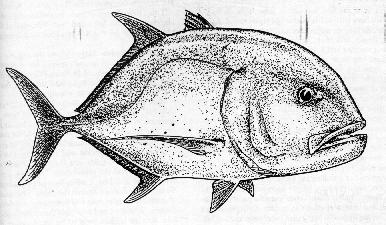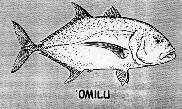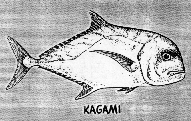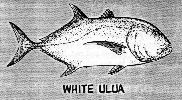- There are four kinds of talakitok:
The "Giant Trevally" or "white ulua" in Hawaii characterized by its
whitish color. It is the largest among the three, found in the deepest water and
well-deserving of their name. "Kagami" is diamond-shaped with a bright
silvery skin, flat body and long filaments. The "Blue Trevally" or
"'Omilu" is the smallest of all four rarely going over 20 lbs. and can be found
in shallow waters. The last is the "Cuba" which has a dark skin much like the
ordinary tilapia.
- The trevally or talakitok is every
man's fish, yet no man's fish. Everyman's? They are caught using every fishing device from
spears to fishing gear, every method from trolling to slide baiting, and at every depth
from shallow water dunking to deep-sea bottom-fishing.
- No man's? The talakitok is a master
of most encounters. Strong and stubborn, this pugnacious battler beats the angler
physically even when the man's tackle outlasts the fish and the man's skill and muscle
bring him to victory. As such it is literally a
"mule with fins". Not only that, but the capture of a big talakitok grips the
angler and never really releases him. The encounter remains vivid and is relived
continually anytime someone can be forced to listen.
- Furthermore, because the talakitok
grows to heroic proportions, the dedicated angler's dream is to beat the 100-pounder. Then
a 179-pounder was caught by bottom fishing in Hawaii, followed soon after by the spearing
of a 191-pounder, also in Hawaii.
- Once hooked, most of the talakitok
will often head for the reef or rocks rather than open water, so the angler must
constantly apply as much pressure as the tackle will bear or else the line will most
probably be snagged by the talakitok. Therefore, it is of crucial importance that
immediate pressure be applied when one uses the trolling method of fishing. It is also
necessary to keep the drag set as strongly as the line and leader can take. A striking
talakitok will try to head for the rocks below. A firm drag can prevent him from turning
his head. This will give you a greater chance to pull him out into deeper water,
increasing your chances of boating him.
- Inevitably in talakitok
fishing, a hooked fish will reach safety in the rocs, snagging your line in the process.
That's not necessarily the end of the battle. Release the tension on the line, loosed the
drag, switch the clicker on again and wait. Frequently, the talakitok will free himself
and the fight resumes. Be prepared to wait for hours, if necessary. It can take that long.
|



